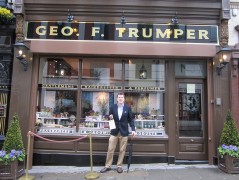Jermyn Street and Beau BrummelPosted on 2012/05/08 20:18:25 (May 2012).  [Saturday 28th April 2012] [Saturday 28th April 2012]
Having seen it featured on The Chap's website I'd been wanting to buy a bottle of Geo F. Trumper's "Extract of Limes" cologne for a while. Today as we didn't particularly have any plan we decided to head for some gentleman-esque shopping on Jermyn Street.
Whilst there I also took a few pictures of the statue of Beau Brummel, to help write a piece on Pinwheel. As Pinwheel isn't completely open to the public yet I shall copy and paste my article here:
Beau Brummel: Inventor of the Suit
There's a statue of Beau Brummel (1778 - 1840) here, fittingly on Jermyn Street in St. James's, a street which specialises in shops selling traditional gentlemen's clothing and accessories, from shirtmakers and shoe shops to "grooming requisites".
Brummel was a style icon of his day, and helped by his friendship of the Prince Regent (who would later become George IV) effectively set the agenda for men's fashion in England during that period.
Prior to Brummel the fashion amongst men in the upper classes had been for ostentatious and flamboyant costumes. Often outlandish, brightly coloured, gaudily embroidered and sometimes bordering on the effeminate. The most extreme example could be seen in the "Macaronis" (essentially 18th Century hipsters).
Brummel advocated a more restrained and sober style, of well tailored but plain dark coloured jackets, full length trousers, white shirts and knotted cravats - the forerunner of the tie. Effectively this was the template for the modern suit as we know it today. It's amazing to think, in a way, what a specific garment a suit is, and how this one style of dress has become such a de facto standard the world over - and we largely have one man to thank for this.
Brummel is entwined with the early history of Savile Row. Although Henry Poole - the first tailor on the Row - did not move there until a few years after Brummel's death, both Brummel and the Prince Regent were customers of several of the tailors that would later relocate there. Of particular note are Meyer and Mortimer, and Jonathan Meyer likely played a key role in helping to develop Brummel's style. Meyer and Mortimer still exist today, based in Sackville Street, close to Savile Row.
Even if you never wear a suit you almost certainly wear trousers. It seems like an incredibly obvious type of garment, and yet, before Brummel, full length trousers barely existed - men wore knee length breeches.
It isn't just the invention of the suit we have Brummel to thank for. Another "fashion" he started was that of personal hygiene. He was in the habit of taking a bath every day, which at the time was considered radical - so much so that people would come to visit his house to witness his daily ablutions. Even amongst the upper classes bathing was a rare event, and bodily odours tended to be masked with powders and perfumes.
Given Brummel's huge contribution to making the modern world what it is today, it is surprising he isn't more famous really. At least on Jermyn Street everyone knows who he is.
Comment 1
He was also inadvertently the inventor of socks, as the longer trouser length meant the kiss of death to the stocking industry for men.
Posted by John's Mum at 2012/05/09 09:11:51.
| Post a comment |

